Arki – the Island that Broke my Shoes!
I arrive on Arki from Patmos on the Dodekanisos Pride or as I’ve come to call her – the Bouncy Bouncy. The thing I love about the Dodek fleet is the way the crew help you on board with your luggage and have it all lined up for you when you disembark. I know this is more to do with efficiency because let’s face it – those speedy bad boys don’t hang around! The journey to Arki is short but as we sail out of the shelter of Patmos into open seas the boat does begin to rock to the point where everyone on the outside deck is hanging on for dear life to whatever they can lay their hands on! Arrival is gentle – a far cry from the chaos of the Nissos Chios at Fourni.
My host Stami at Katsavidis Rooms is on the boat too having been over to Patmos for supplies. I already know that Arki is small, doesn’t have a cash machine, not many places accept card payments, no pharmacy – just a couple of tavernas and pensions and a mini market. I came prepared with plenty of cash and a good supply of sunscreen and insect repellent!
I’ve heard Arki described as a remote island. I wouldn’t call it remote being in close proximity to Patmos, Lipsi, Leros and not too far from Samos but it is small. I had to think about whether 7 days on such a small island was too much but after three weeks of bouncing from one island to the next, this is an opportunity to have a bit of downtime.
Stami’s husband Nikos drives me to the rooms after dropping off another local at the old port. The Dodekanisos Pride docks at the new harbour and there is a steep bluff that takes you over towards the old port which is the heart of the only settlement on the island. Katsavidis Rooms a short way up hill and has a small church practically in the front garden.
I take my time to unpack, do the washing, go to the mini market for the basics such as water and then that is it for me. After my big lunch on Patmos I wasn’t hungry. Knowing that I have 7 nights here I’ve no rush to leap around and explore. For now I can relax.
The following morning I am up early and now fully energised and ready to get out and explore. It is 6.30am and there is a nice cool breeze blowing so a great time to do some walking. As I leave my room I can hear the clinking and clonking of goat bells which compels me to head up towards the sound.
The road that starts at the old port continues up a steep hill. At one point there is a metal gate but I deduce this is some kind of containment for the goats. And I’m right. When I get to the top of the hill, over to the left is a huge herd of goats of many different types. Some with huge curved horns and others with little stubby ones. As I approach them, several goats appear to stand to attention like soldiers guarding their fort. Just beyond the gaggle of goats I can hear a man shouting “Yah!” “Yah!” at the goats and the clinking and clonking becomes a cacophony of noise as they scatter out of his way. There are goat skulls attached to gates and fences almost everywhere. I do wonder if there is a hierarchy of bell. The deep clonking ones for the rams and the high pitched clinking for the ewes with the young kids remaining bell free until they come of age – a sexist view I know!
I decide to turn around, not sure if there is a way through and I head up in the opposite direction to the Panagitsa Church that sits high on a hill. The sun has just risen over the hill and begins to light the valley below. The island is every shade of khaki, mustard, brown and green that covers the gently rolling hills – it almost looks like it’s wearing a coat of camouflage. The light on this island, especially in the morning and the evening is one that will make artists weep with emotion.
The low-growing shrub appears to have been scorched by the sun and the wind as there isn’t much protection but there is an overwhelming feeling of openness that invites you to roam freely – it’s a pretty special feeling.
From the vantage point of the church, there are great views over the island and to the other small islets that make up this archipelago. I can also see over to Patmos on one side of the island and Samos on the other.
It is Sunday today but despite the number of little churches that litter the landscape there doesn’t seem to be any signs of activity – no church bells ringing. I guess on a small island with only 54 inhabitants (2001 census) your own local priest is a bit of luxury.
It’s now time for breakfast so I head back down to the main square. The square is really pretty and there are several people sweeping the road, watering plants and making sure it is ready for customers which seem to be predominantly the yachting community.
There are two tavernas in the square – Trypas Taverna and Taverna Nikolas. Both also have rooms available to rent. I had been in contact with them both along with Katsavidis Rooms in a bit of blind panic that with limited accommodation (52 rooms on the island in total), I would be left stranded with it being the mid to end of July. They all responded to me with vacancies but Katsavidis got their first!
I decide to have breakfast at Taverna Trypas. I order the special omelette and toast with homemade apricot preserve which I can tell you is pretty special! A selection of Twinings teas are brought to the table in a wooden box.
When you see the sign above the taverna and the logo on the menu it won’t take you long to work out who the owner is. Manolis is a very dapper gentleman whose trademark is his straw Panama hat worn with a brightly coloured neckerchief. One evening he changed into a silk chinese style top, black cropped trousers and skull cap – obviously a man with a great sense of style.
A lot of care and attention has gone into making the square really attractive. Along the harbour fishermen are returning with their catch and the son of Manolis is sitting under a red umbrella descaling fish to be cooked in the taverna later. He has an audience of many cats waiting for a morsel to be thrown their way.
After much needed sustenance I’m ready to get back on the road before it gets too hot. I get out Google maps. There aren’t many roads on the island so it’s easy to see that there is one road from the square that goes to Tiganakia Beach which is supposed to be one of the most beautiful in the Dodecanese. When I say road – these are narrow concrete roads that look relatively new – maybe 2002 as imprinted on the road along with goat hoof prints who clearly weren’t behaving that day! There aren’t many cars on the island and most people seem to get around by moped or on foot.
The road starts off well but at some point the concrete ends and it becomes a mud road laced with rocks – and lots of them. This is a very rocky island that reminds me a bit of Kasos – not much in the way of agriculture or rich vegetation. Hats off to the people that originally decided to settle on what seems such an inhospitable land with no natural water supply or means to be self-sufficient.
My favourite footwear of choice is my Birkenstock sliders – actually the sandals I have at the moment are a very similar brand called Genuins. I buy at least 4 pairs of these every year and wear them every day for walking. Probably not the most sensible of shoes for some situations but boy are they comfortable – so comfortably I barely know I’m wearing them.
Anyway, continuing on this rock path in my own little world, I nearly jump out of my skin as several goats that had been sheltering from the sun, run from underneath a small tree. This really is goat island!
A bit further down I reach another ‘goat containment’ gate. Once through the gate, I can see signs of some new construction in progress – some houses look complete and others are still at the foundation stage but none of them currently lived in. Perfect for people who want to live in seclusion. Just as I reach the beach there is another gate – I guess you can say that this is going to be a gated community but not one to keep undesirable people out – but the goats!
Tiganaki Beach is peaceful with not another soul here. The beach is stoney but the water is turquoise and crystal clear. Conscious that it is now beginning to get hot and I need to make my way back across the open landscape I stay just long enough to have a walk around and take a couple of snaps.
Before I reach the village I see a sign for Taverna Apolafsi. It is down a steep path but having drunk all of my water I’m in desperate need of a drink. The taverna is a little out of the village so I can’t imagine it gets much custom. It is a nice little place which looks as though this is the house of someone who decided to add a few tables and chairs to his garden and call it a taverna which is really sweet. I make a note to come back one evening.
Further down there is a little lagoon with a small jetty and the tiniest of beaches which I’m sure is used by the family of the Apolafsi Taverna family.
I relax on my balcony for the rest of the afternoon. I’m not particularly hungry as I think I have a touch of sunstroke which isn’t much fun, but later that evening I do force myself out to eat. Before I head to the square I walk along the path to the right, past the solar power plant, past a machinery graveyard where all sorts of abandoned vehicles and discarded items have been laid to rest. I walk past a helicopter landing pad until the path comes to an abrupt end at what looks like the island rubbish dump. Rabbits skips across the road when they hear me approach. Thank heavens they were rabbits!
Anyway, back to the square to eat. Ip dip dash, my blue ….. – It’s Nikolas Taverna. I have something really simple, chicken souvlaki and a glass of wine that is filled to the brim! Nikos from Nikolas Taverna are from the same family as Stami. Her husband Nikos is a cousin of Nikos. Stami’s husband Nikos’s mother is the aunt of Nikos from Nikolas Taverna.
Now Arki may be a small island and lacking some facilities (ATM, good wifi, pharmacy) but it isn’t in the dark ages. Both taverna’s in the square are really pretty with brightly painted wooden chairs and tablecloths. Trypas Taverna has its humorous Weather Forecasting Stone and will play laid-back jazz beats whilst you dine and it has a certain hippy vibe about it.
At Nikolas Taverna Niko’s papa Christos is clearly a man of many talents and has made the boats you see suspended on string all around the tavern. He also made the miniature boats that float in the shallows next to the taverna – each one telling their own story. In the evening you can see him flying a kite with his grandchildren. I did ask Stami one evening if the boats were modelled on real ones or from Christos imagination and she said she thinks it was a mixture of both.
One evening I meet Stami in Nikolas Taverna and bombard her with the many questions that I’ve been saving up. When were the first settlers on the island? Why were there no church services on Sunday – where does the priest come from? What happens if someone gets sick? Is it possible to see how the cheese is made at the goat farm? How do I get across to Marathi? When do the boats go to Lipsi?
Stami is from Athens but lives on Patmos – it is husband Nikos that is from Arki. They both come to stay on Arki only for the summer so call to various people in the taverna to help answer the questions.
Nobody really knows when the first settlers came to Arki. We know there is an old Roman fort on the island and Nikos says that his grandfather was born on the island but that is as much as we can gather. She tells me that priests will come from Patmos to deliver special services as and when required. On Wednesday there is a service to mark the 40 days since the passing of one of the islanders in the church on the way to Taverna Apolafsi and I would be welcome to come.
For the boats to Marathi, they will ask Manolis the local fisherman and he will take me and collect me on whatever day and whatever time I like. As soon as the wind dies down I’ll look at this as an option. To get to Lipsi and back in the same day there are two options. The Lampi and the Leros Express – both dependent on weather conditions. The Lampi will only give you an hour or so on Lipsi whilst the Leros Express will give allow for a stay of seven hours from 9am until 4pm.
There are several reasons why I want to go to Lipsi – the first being just to refresh my memory of it. I was there in 2004 staying with a really lovely family close to the port. It was memorable because we were there when Greece qualified and then won Euro 2004. We watched the matches with the family on the roof terrace of the pension. Lipsi is so small that when the cavalcade of cars and motorbikes took to the streets to circumnavigate the island – you could almost see them at every point along the way. I have really wonderful memories of this stay.
The second reason why I’d like to get to Lipsi is to buy some antihistamine to help bring down the mosquito bites I have had since arriving on Arki. These little pests are like stealth bombers – you never actually see them but there are ferocious and I’m currently being eaten alive by them despite covering myself fervently in a Deet based product! Apparently mosquitoes are a big problem on Arki as I’m discovering. However, on the upside – there are no wasps! I was getting pretty fed up of being bothered by wasps every time that I had a meal on Fourni so this is a big positive.
Anyway, back to trecking the island. My next walk takes me up to the goat farm above Katsividis Rooms again where I plan to check out Lemnari Beach and the Roman fort. As I arrive at the goat farm the Yah! Yah! man greets me with a cheery Kalimera, large steaming cup of hot goats milk in hand. I ask “Paralia?” and he points me in the direction to go. It is at the goat farm that the concrete road ends and once again the mud and rock path takes over. This is much more difficult to walk on as the sharp limestone rocks are much more pronounced. This path takes you down a steep incline through another goat containment gate and along the cliff edge. I can see the beach below and despite being secluded I can see there is one person down there sunbathing. The walk down to the beach looks quite precarious – besides I’m not here for swimming. I carry on along the path looking for indications of the way to the Roman fort which I believe is at the tip of the island. The further down I go the more rocky it gets. At the bottom I seem to reach a dead end that culminates in another goat farm. Beyond the farm I can see what looks like a white house poking out above some trees but I can’t see a way beyond the wall. Sometimes you just need to admit defeat and do and about turn.
The walk back up is much harder work, especially on my sandals which are being given a really hard battering. I just hope that they hold out until I reach the concrete road again.
Back at the big goat farm the Yah! Yah! man gives me a cheery “Yasou” as I wave goodbye to him.
Back at Katsavidis Rooms I inspect the footwear. Two days in, two walks and the shoes are dead! It is with great reluctance that I have to lay my shoes to rest – in the bin! Lucky for me a have another pair as back up!
When I speak to Stami again it seems that to get to the Roman fort you have to go inland over the hills – there is no pathway and it doesn’t even appear on Google maps so maybe I’ll just have to let my curiosity on this one slide!


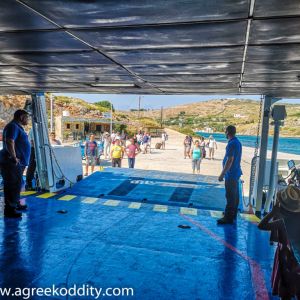

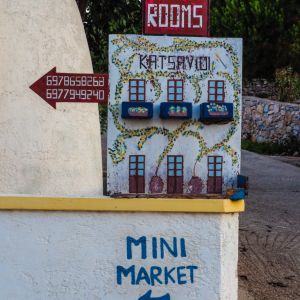
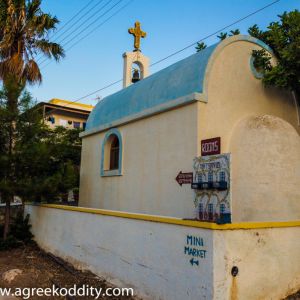

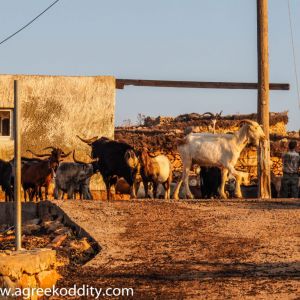
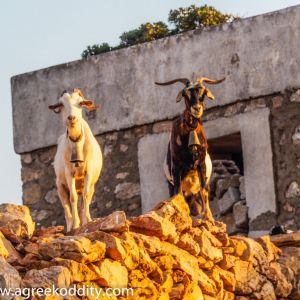

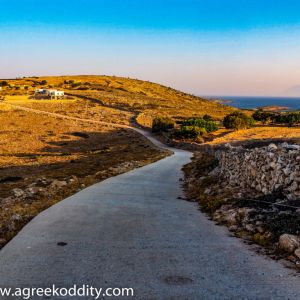

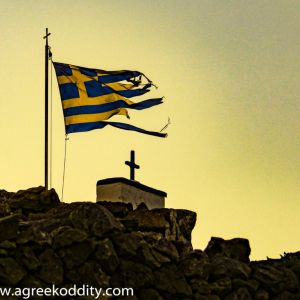
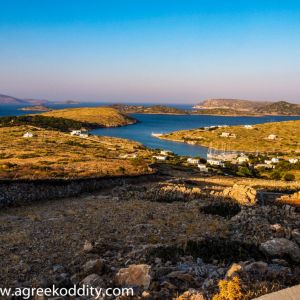

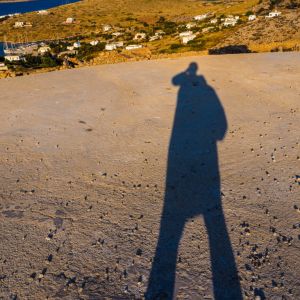
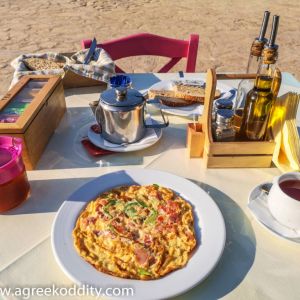

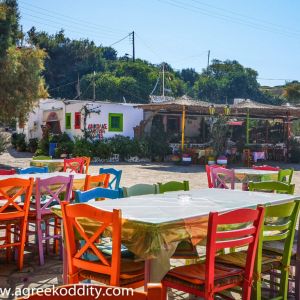
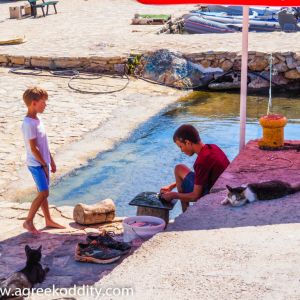
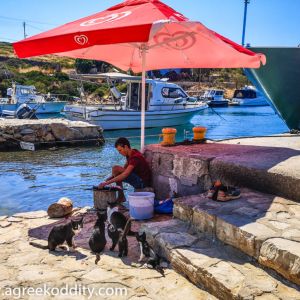


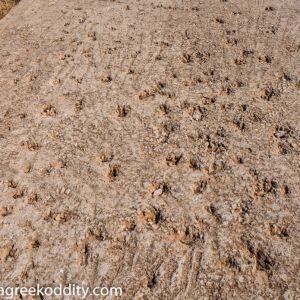


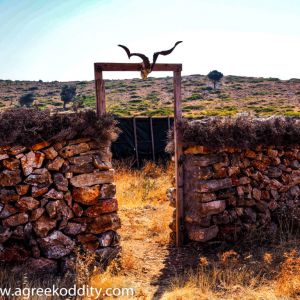
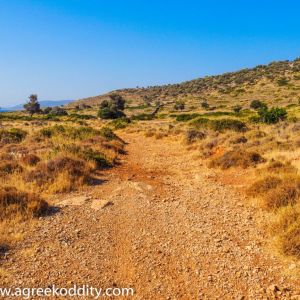
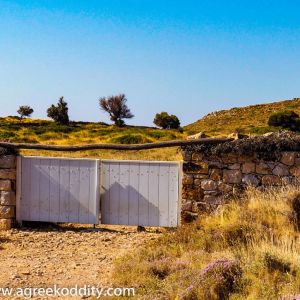


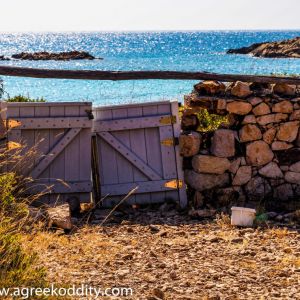

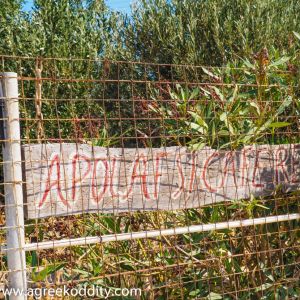


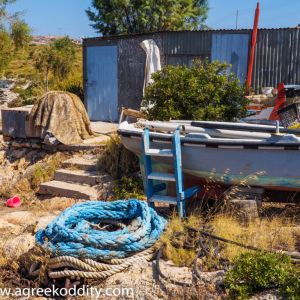

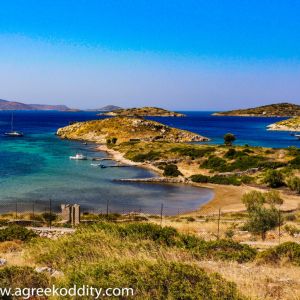
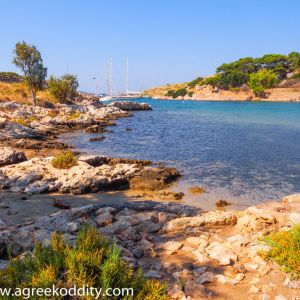

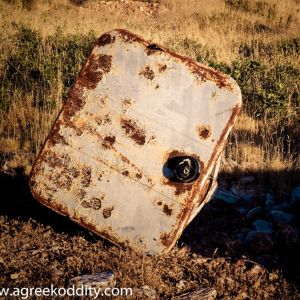
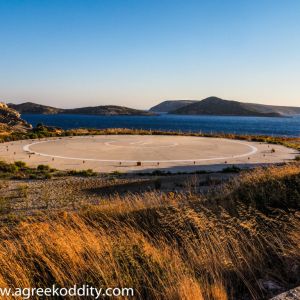
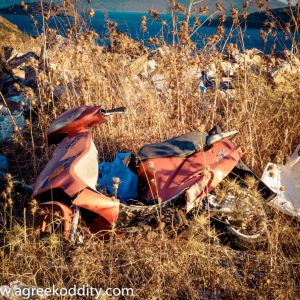
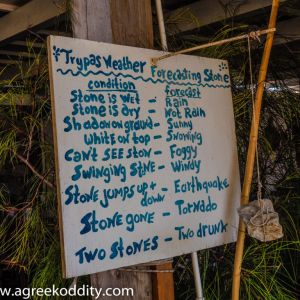



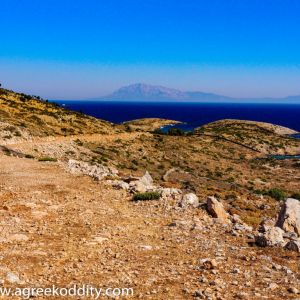
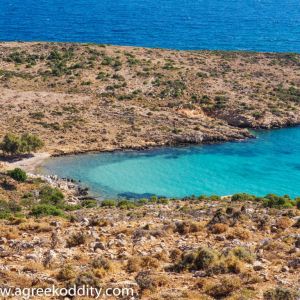
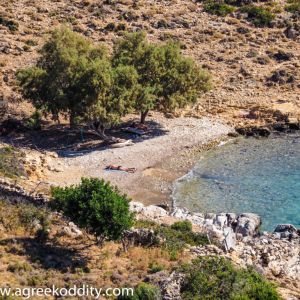
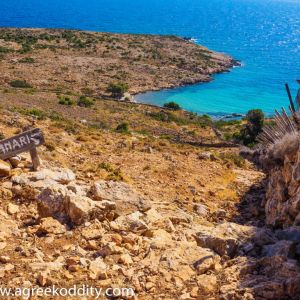

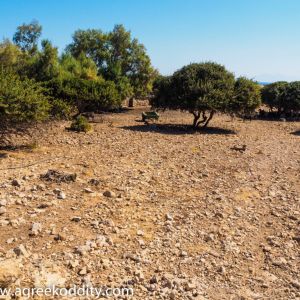
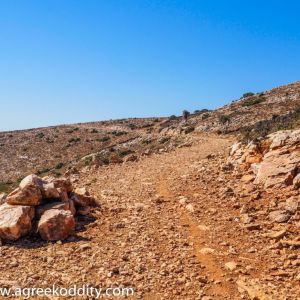
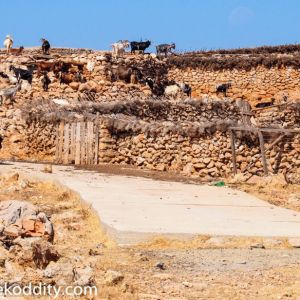
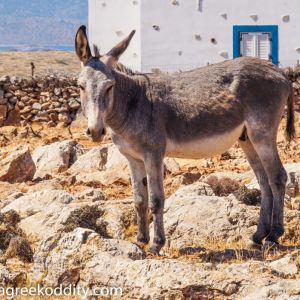
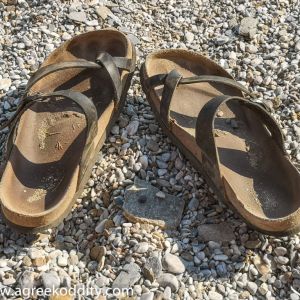






So cute